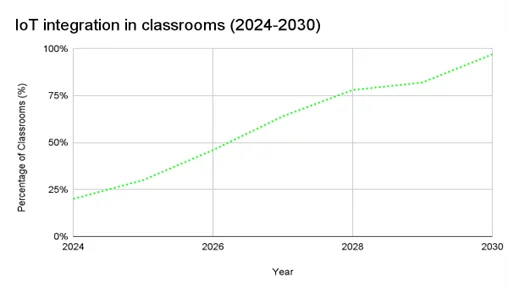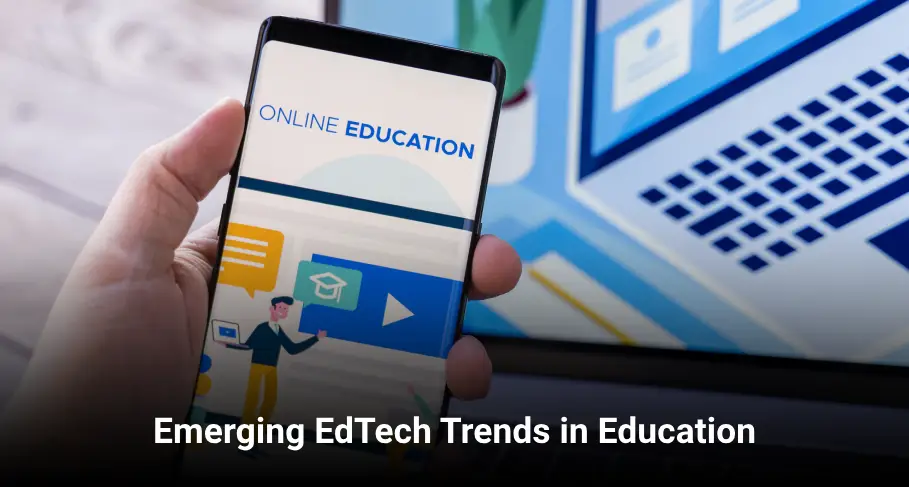The EdTech industry globally is predicted to reach $404 billion by 2025 (HolonIQ). This growth is driven by the integration of technology and improved teaching approaches.
Here are some key emerging trends in EdTech:
AI in Personalized Learning
Artificial intelligence is transforming education, with Gartner’s research report stating that the global AI in education market is set to be worth more than $6 billion by 2025. The growth is due to AI offering tailored learning experiences, adapting to every student’s wants and preferences, thus improving educational outcomes.
Gamification and Interactive Learning
The adoption of gamification in education is rising exponentially, with the global market value likely to exceed $30 billion by 2027 (KPMG). This approach will help transform learning into an engaging, interactive process, providing student motivation and participation.
VR/AR for Immersive Learning
As per a study report furnished by IBM Research, virtual and augmented reality in education will be worth more than $20 billion by 2026. These technologies provide students with immersive and interactive learning experiences, making education more attractive and effective.
For example, in an AR-based French language learning app, students are immersed in a virtual market in their living room, where they can interact with digital stores and packaging labelled in French. In this experience, shop owners engage students in casual conversations to create meaningful discussions. Some features, such as speech recognition, help analyze and enhance pronunciation, making this AR experience more efficient and enjoyable to learn French than traditional online methods.
Blockchain for Credential Verification
The relevance of blockchain technology is growing rapidly in the educational sphere, specifically where the validation of qualifications is concerned. As projected by Gartner, 30% of educational institutions will capitalize on blockchain for secure document handling by 2026, thereby safeguarding the credibility and genuineness of scholastic transcripts.
Data Analytics in Education
The role of data analytics in education is expanding rapidly. According to an article by EdTech Magazine, the education data analytics market could reach around $50 billion by 2027. Data analytics is revolutionizing educational strategies, leading to better learning outcomes.
Cloud Computing in Education
Cloud computing in education is projected to reach a market size of $36.5 billion by 2025 (Educause). This technology facilitates remote learning and access to educational resources, enhancing flexibility and collaboration.
For instance, to deploy cloud computing for education, a school utilizes cloud-based platforms to store and manage educational content, student data, and administrative information. This allows teachers and students to access learning materials and software tools online from any location, fostering collaboration and supporting remote learning opportunities.
Internet of Things (IoT) in Classroom Integration
IoT in education is a rising trend, with the market likely to reach $11.3 billion in value by 2026 (Allied Market Research). IoT devices are helping enhance classroom interactivity and connectivity, extending a more integrated learning environment.

Wearable Technology
Wearable technology has proven to be a game-changer in the education sector, with its market expected to grow in the times to come. According to a report by Global Market Insights, the market for wearable devices in education is projected to reach $6 billion by the end of 2026.
These devices such as smartwatches and VR headsets, are improving learning experiences by offering interactive and immersive educational opportunities.
For example, smart glasses help provide real-time language translation to international students, while VR headsets, on the other hand, help students visualize and see historic places and scientific explorations. This integration of wearable technology makes learning more interactive and engaging. It caters to diverse learning styles and needs, paving the way for a more inclusive and technologically advanced educational environment.
Adaptive Learning Technologies
Projected to have a market value of $5.2bn by 2026 (Valuates Reports), adaptive learning technology is gaining momentum. These technologies provide personalized learning experiences that adjust according to the learner’s performance and feedback.
Conclusion
The next chapter in education development is accompanied by a shift from traditional learning environments due to new trends in educational technology. The emergence of this era has been marked by the integration of interdisciplinary technologies and educational theories, which promote an all-rounded approach to learning. In addition, wearable tech brings biometric and environmental data into learning, allowing teachers to know what students need at any time. Besides just smoothing administrative processes, incorporating blockchain technology within academia will lead to more trust and visibility for academic certificates.
Moreover, collaborative platforms are spreading alongside social learning tools which have started fostering knowledge sharing culture with the rest of community learners while breaking down those silos to foster global connections. These technologies are maturing into an adaptive, responsive, and personalized yet universally accessible learning ecosystem that has and will widen the doorways for lifelong learning opportunities irrespective of one’s background.


